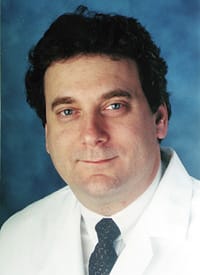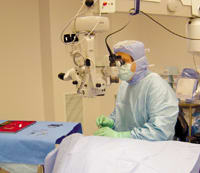Quality Over Cost:
An Equation for
Long-term Growth
Excellent outcomes, a growing patient base and a healthy bottom line support this
ASC's approach.

At Main Line Surgery Center, our formula for developing and growing a successful high-volume ophthalmic ambulatory surgery center (ASC) is based on a positive response to a single question: "Is it good for our patients?"
If the answer is yes, then we know that any decision we make ultimately will have a positive long-term effect on the surgicenter. This approach veers drastically from the lowest-cost-per-case formula that drives many large surgery centers, but our excellent outcomes, burgeoning patient base and healthy bottom line confirm that it's the right choice for us.
About 20 ophthalmologists use our ASC, which is located in Narberth, Pa., a suburb of Philadelphia. Because of their diverse expertise, we can provide pediatric, glaucoma, retina, cornea and cataract surgery, as well as other anterior segment procedures. We perform a full range of ophthalmic surgery and use high-quality equipment to provide the best possible service to our patients. This arrangement works well for the patients, but it also works well for us.
In this article, I'll share some insights on our overriding philosophy.
|
|
|
|
"I wouldn't use a technique or a device on a patient -- regardless of cost -- that I wouldn't recommend for a member of my family." -- Rich
Tipperman, M.D. |
The Golden Rule
Our aim of providing the best quality of care isn't limited by the proviso "within a certain price point." Some ASCs realize a fleeting return on investment (ROI) based on a penny-wise pound-foolish administrative plan. Our aim for long-term growth is based on the golden rule: Do unto others, as you would have others do unto you. I wouldn't use a technique or a device on a patient -- regardless of cost -- that I wouldn't recommend for a member of my family. If the most expensive product on the market is the one that will ensure the best outcome with the least risk of complications, how could we afford not to use it?
Our golden rule philosophy drives our use of the AcrySof Natural IOL, for example. This lens has a low rate of patients requiring YAG capsulotomy, and while some might suggest that any lens that requires fewer YAGs actually reduces revenue, we don't see it that way at all. We see it as an opportunity to achieve better clinical results -- with fewer potential complications -- and to grow our practice revenues over time. So, although it's a short-term loss, it's a long-term victory.
We're building our ASC's reputation one happy patient at a time. Every person who comes into our building is an ambassador who can grow the center through word-of-mouth referrals. It's our job to cultivate positive experiences for them. Surgery centers require an astronomical investment. Growing the practice protects that investment. In medicine, we're really only as good as our last case, so it's important that we take a long-range approach to achieving our ROI.
Our per-case cost could be lower if we looked at cost alone. But in the long run, it doesn't take that many unhappy patients, that many problems, that many less-than-optimal results to bury a practice and an ASC over time.
Attracting Top Surgeons
Patients are our most important market, but surgeons are an important secondary market. We need to convince them that this is the only place to bring their patients for surgery.
How do we attract top surgeons? First, by housing the best and newest equipment available and second, by allowing them the freedom to choose their surgical techniques and devices. It's a symbiotic relationship. We buy the best equipment, which attracts the best surgeons who bring their expertise and patient base to our ASC.
Because we have access to the latest technologies, we can support a new surgeon during the learning curve by sharing our expertise with new devices and procedures. In some ASCs, surgeons are curtailed from using certain IOLs if they increase the cost per case. Other facilities go so far as to question the extra cost of sutures in a cataract case that seemingly could have been done without. Surgeons don't want to operate in an environment where their professionalism and expertise are undermined by penny-pinching.
|
|
|
|
|
|
Value-added Benefit
The saying, 'you have to spend money to make money,' explains our purchase of a Zeiss IOLMaster. We were the fifth practice in the country to acquire this technology, and although it set us back nearly $30,000, the purchase has worked well for us on several levels.
Although we're spending more money per case, the IOLMaster enables us to get the best possible clinical results for our patients; it also allows the surgeons who operate in the surgicenter to use it to confirm their measurements, which provides a great value-added benefit.
Finally, if a surgeon in the community doesn't use our ASC but refers a patient because he wants the patient to have the benefit of the IOLMaster, we then have the opportunity to gain a new patient who sees the center and decides he'd like to have his surgery here.
Purchases like the IOLMaster enable us to access the 'time, money, quality' triad that's so often elusive. It saves us time in determining our cataract patients' lens strengths; it attracts new surgeons -- and their patients -- so it's a revenue generator; and it enhances the quality of our outcomes. Few situations let you realize the benefits of all three, but by factoring in better outcomes, we're able to bring in quality.
Our purchase of an endocyclophotocoagulation (ECP) unit is another example of a costly expenditure that's reaping quality rewards for our center. Many of our glaucoma patients have drastically decreased their medications after ECP, and their positive experiences will have a ripple effect in the community, bringing more patients back to us. We had to give considerable thought to the expenditure of about $60,000, but ultimately, we felt if we didn't make those advances and upgrades, we'd be stifling growth.
Success Through Differentiation
We differentiate our center by having equipment and technology that's either as good as or better than any of the surgicenters in the area. But we don't market that to prospective patients because experience tells us they don't want to hear about bells and whistles.
Our patients don't want to know that our center has the best phacoemulsification machine or the most advanced microscope or that we're using the best lOLs. They want to know their ophthalmic problem will be alleviated, the facility will be comfortable and the staff will be sensitive to their needs.
Decisions by Committee
When choosing new equipment, we ask, 'how will it help our patients?' Will it speed the process or improve our outcomes?
We like to make major equipment choices by consensus, which can be quite cumbersome with 23 physicians involved in our ASC. However, our entire group of surgeons is committed to delivering the best quality of care for the long run, so most of the equipment decisions become clear cut. It's still important that everyone have a say in the process and be comfortable with the final decisions.
Our administrator considers cost when making purchasing decisions, and in cases when all other factors are equal, she goes with the lowest price. However, in the case of reusable tubing, which looked particularly appealing from a cost perspective, she was overruled by our director of nursing, who was adamant about using only single-use devices to avoid the potential for contamination.
Our nursing director also takes issue with the time and labor associated with processing and sterilizing reusable tubing. And single-use tubing is the standard of care in our community, so the decision to commit to disposables was heavily weighted in their favor. We believe that relying on single-use devices is simply another example of our commitment to do what's best for the patient.
Choosing a Vendor Partner
There certainly is an advantage to finding a single vendor who can supply everything, and among those advantages is being able to negotiate the best possible per-case price.
When we were developing the surgery center, we contacted several ophthalmic companies, explained that we planned to choose a primary vendor and asked for their best price. Alcon's flexibility and willingness to work with us placed them in the lead.
We feel strongly that even though we're partnering with a company that provides the best products at the best prices, we want to have access to other vendors as well. This is crucial if we want to try new equipment from another vendor, or if one of our affiliated surgeons prefers to use a different company's products. We never have to look over our surgeons' shoulders to see what they're using, and that's important because the long-term fiscal health of our ASC depends as much on happy surgeons as it does on happy patients and good clinical outcomes.
Partnering with a premium products company is a win-win situation. Not only do we get excellent products that contribute to impeccable outcomes, but our vendor reaps the rewards of a consistent relationship with a high-volume, full-service surgery center. This in turn provides us with increased leverage in price negotiations.
Another advantage of partnering with a premium product supplier is that we're privy to the newest technology in the pipeline and often have trial-run access to it before others, which is how we've always chosen our phaco systems.
|
|
|
|
The AcrySof Natural IOL has a low rate of patients requiring YAG capsulotomy. --Rich Tipperman, M.D. |
ASCs in the Future
Advances in cataract surgery and widespread knowledge of refractive surgery have merged to influence our cataract patients' expectations. In effect, we've spoiled our cataract patients who end up disappointed if they're not 20/20 uncorrected post-op.
While this dynamic challenges us to continue perfecting our techniques and acquiring cutting-edge equipment, it also foreshadows a tremendous opportunity for ASCs in the coming years. As we begin to treat presbyopia with lens implantation, and explore other developing techniques that combine the principles of cataract and refractive surgery, our ASC gains another opportunity for growth and differentiation. It also gains the chance to command a premium price for premium service, which of course, is not an option with cataract surgery because of fixed reimbursement.
When we opened our ASC, patients often would question why they weren't having their surgery at a nearby urban or suburban hospital. They were concerned and fearful at the prospect of undergoing surgery in the ASC, because at that time, it was an unfamiliar concept, and perhaps they thought it was a cut-rate approach.
Today, after 6 years of developing a high-quality reputation one patient at a time, we hear just the opposite from patients who say they'd rather have their surgery in our center. Using high-quality products and providing high-quality service in a comfortable environment has allowed us to grow our surgical volume from less than 1,000 cases our first year to almost 4,000 cases this past fiscal year.
Dr. Tipperman practices at Main Line Surgery Center in Narberth, Pa.











